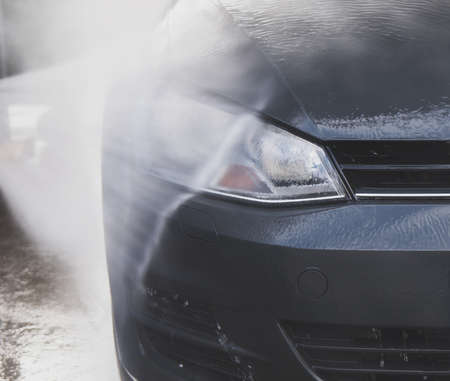1. Regular Inspection and Cleaning
Keeping your performance exhaust system in top shape starts with regular inspection and cleaning. Neglecting these essential steps can lead to rust, leaks, and debris buildup, which could reduce performance and shorten the lifespan of your system.
Check for Rust
Rust is one of the biggest enemies of any exhaust system. Moisture, road salt, and extreme weather conditions can speed up the corrosion process. To prevent rust:
- Inspect your exhaust system regularly, especially during the winter months.
- Look for any signs of discoloration, flaking metal, or holes.
- Apply a high-temp rust-resistant coating if needed.
Inspect for Leaks
Exhaust leaks can reduce performance and cause unwanted noise or even dangerous fumes inside the cabin. Common signs of exhaust leaks include:
| Leak Indicator | Possible Cause |
|---|---|
| Loud or hissing sounds | Cracked or broken pipe |
| Reduced engine power | Loss of exhaust pressure |
| Stronger exhaust smell inside the car | Leak near the cabin area |
If you notice any of these symptoms, have your exhaust system inspected by a professional or seal small leaks with high-heat exhaust sealant.
Clear Out Debris Buildup
Over time, dirt, road grime, and carbon buildup can accumulate inside the exhaust system, restricting airflow and reducing efficiency. To keep your system clean:
- Use a soft brush and mild degreaser to clean the exhaust tip regularly.
- Inspect the undercarriage for road debris that may get lodged in the pipes.
- If you notice excess soot buildup, consider using a fuel additive to help clean internal carbon deposits.
Pro Tip:
Washing your car frequently, especially during winter, helps prevent salt buildup that can accelerate rust. A good rinse under the vehicle can make a big difference!
2. Checking for Loose or Damaged Components
Over time, your performance exhaust system can be affected by vibrations, road debris, and heat cycles. Regularly inspecting your system for loose or damaged components can help you avoid costly repairs and ensure optimal performance.
Inspecting Hangers and Clamps
Hangers and clamps secure your exhaust system in place. If they become loose or damaged, your exhaust can sag or even detach. Here’s what to check:
| Component | What to Look For |
|---|---|
| Hangers | Check if they are cracked, broken, or missing. |
| Clamps | Ensure they are tight and not rusted or corroded. |
Examining Exhaust Piping
Your exhaust piping is constantly exposed to heat and road debris, which can cause cracks or rust. To prevent system failure:
- Look for visible cracks, dents, or corrosion.
- Check for black soot stains, which indicate leaks.
- Listen for abnormal sounds such as rattling or hissing.
How to Fix Loose or Damaged Components
If you find any loose or damaged parts:
- Tighten any loose clamps with a socket wrench.
- Replace broken hangers with new ones that fit your vehicle’s exhaust setup.
- Use high-temperature exhaust tape or sealant for minor leaks and cracks.
- For major damage, consider replacing the affected pipe or taking your vehicle to a professional.
Regularly checking these components helps prevent excessive movement and ensures your exhaust system functions properly.
![]()
3. Three, Proper Heat Management
Managing heat properly is crucial to maintaining the performance and longevity of your exhaust system. Excessive heat can lead to component failure, reduced efficiency, and potential safety hazards. One of the best ways to control heat is by ensuring that heat shields and wraps are in good condition.
Inspect Heat Shields Regularly
Heat shields play an essential role in protecting sensitive components, such as wiring, fuel lines, and the vehicle’s underbody, from excessive heat. Over time, these shields can become loose, damaged, or even fall off completely. To prevent potential issues, check the following:
| Heat Shield Component | Signs of Damage | Action to Take |
|---|---|---|
| Exhaust Manifold Shield | Rust, cracks, or missing sections | Tighten bolts or replace if necessary |
| Piping Heat Shields | Rattling, corrosion, or misalignment | Secure or replace damaged parts |
| Catalytic Converter Shield | Heat discoloration or detachment | Reattach or install a new shield |
Use Quality Heat Wraps When Needed
Heat wraps help to control exhaust temperatures and prevent surrounding components from excessive heat exposure. However, applying them incorrectly or using poor-quality wraps can do more harm than good. Keep these points in mind when using heat wraps:
- Choose high-temperature resistant wraps designed for automotive use.
- Wrap evenly and avoid excessive overlap to ensure proper heat dissipation.
- Check for fraying or breakdown over time and replace as needed.
Prevent Overheating Issues
A well-managed exhaust system shouldnt cause excessive heat buildup. However, if you notice signs like burning smells, warped components, or loss of performance, overheating may be an issue. Address these by:
- Ensuring that all heat shields and wraps are properly installed.
- Inspecting exhaust system airflow and clearing any obstructions.
- Checking for exhaust leaks that may alter the temperature distribution.
Taking these steps will help keep your performance exhaust system functioning efficiently while protecting other vehicle components from heat-related damage.
4. Four: Using the Right Cleaning Products
Avoid Corrosive Chemicals
Using the wrong cleaning products can damage your performance exhaust system. Harsh or acidic cleaners can lead to corrosion, discoloration, and a shorter lifespan for your exhaust. To keep it in top shape, always check the labels before using any product and avoid anything that contains strong acids or abrasives.
Use Exhaust-Safe Cleaners
To maintain the shine and durability of your exhaust, choose cleaning products specifically designed for metal surfaces or exhaust systems. These cleaners effectively remove grime and oxidation without harming the material. Here’s a quick comparison of common product types:
| Type of Cleaner | Effectiveness | Safe for Exhaust? |
|---|---|---|
| Metal Polish | Restores shine, removes minor oxidation | Yes |
| Degreaser | Removes oil and grime | Yes, if non-corrosive |
| Acid-Based Cleaner | Removes heavy stains but can cause damage | No |
Application Tips for Best Results
For the best results, follow these steps when cleaning your exhaust system:
1. Cool Down the Exhaust
Never clean a hot exhaust system. Let it cool completely to avoid burns and ensure the cleaner works effectively.
2. Apply Cleaner with a Soft Cloth
Use a microfiber cloth or soft sponge to apply the cleaner. Avoid steel wool or abrasive brushes, as they can scratch the surface.
3. Rinse and Dry Properly
After cleaning, rinse the exhaust with water and dry it thoroughly to prevent water spots or residue buildup.
By choosing the right cleaning products and following proper maintenance techniques, your performance exhaust system will stay in excellent condition for years to come.
5. Five. Monitoring Exhaust Sound and Performance
Your performance exhaust system isnt just about looks—its also about sound and efficiency. Any unusual noises or performance drops can be early warning signs of potential issues. Regularly listening to your exhaust system can help you catch problems before they turn into costly repairs.
Identifying Unusual Noises
If you notice any of the following sounds, your exhaust system may need attention:
| Noise | Possible Issue |
|---|---|
| Loud Roaring | Possible leak or damaged muffler |
| Hissing | Leak in the exhaust pipe or gasket |
| Rattling | Loose or damaged exhaust components |
| Metallic Tapping | Potential internal damage or catalytic converter issue |
Recognizing Performance Changes
- Decreased Acceleration: A compromised exhaust system can reduce engine efficiency.
- Lower Fuel Efficiency: A drop in fuel mileage might indicate an exhaust leak.
- Unusual Exhaust Smell: If you smell strong fumes inside the car, check for leaks immediately.
What to Do If You Notice Issues
If you detect any of these warning signs, inspect your exhaust system or visit a trusted mechanic. Addressing exhaust problems early will keep your performance system in top shape and prevent further complications.

